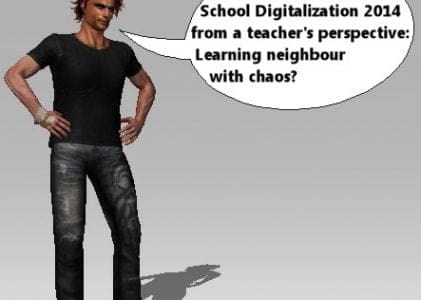 According to Horizon Report Europe 2014, Schools Edition, the
According to Horizon Report Europe 2014, Schools Edition, the![]() digitalization of the European schools will speed up. Many strong indications that in several cases can be interpreted as evidence do exist. The report’s foundation is based on six trends that during the following five years will lead the school into the digital age. In this spirit eLearningworld decided to write this new series of articles in order to integrate these trends in a school environment and in this second part from a teacher’s perspective.
digitalization of the European schools will speed up. Many strong indications that in several cases can be interpreted as evidence do exist. The report’s foundation is based on six trends that during the following five years will lead the school into the digital age. In this spirit eLearningworld decided to write this new series of articles in order to integrate these trends in a school environment and in this second part from a teacher’s perspective.
Where do the trends lead?
The trends that is featured in the Horizon Report is focusing on the teacher role’s transformation that for instance means searching for open learning resources as well as social media that after evaluation will be used and create added value for the education. And besides this instead of using the printed book’s models and descriptions in order to use simulations, make benefit of the interactivity of online learning and other possibilities that it brings, e.g. to analyse learning data of the students activities and result.
ADVERTISING
[adrotate group=”3″]
Learning neighbour with chaos?
In a distant reflection from a teacher’s perspective this seems to lead to chaos especially in comparison with traditional education with its rows of seats, blackboard and printed textbooks. And then we have not even mentioned the time perspective in the report. Since it says that within a year tablets and cloud-based services will be a prioritised component in education. The students will to a large extent use their own tablet/computer, which will decrease the possibilities to control what the students actually are doing with their hardware. In many schools this already is a reality, while in others the computers is stuck in the old computer room, if they at all exist.
A new and reverse pedagogical method will according to the report also get its final breakthrough. At the same time as the teacher will get access to the students learning data in the form of results and activities in different learning modules. Data that she during the following 2-3 years is expected to perform increasingly better analysis around, not only to follow every students progress but also to use to individualise the learning environment to every students unique learning style.
New learning environment
Other components in this digital learning environment is gamification, in other words to use mechanisms and dynamics in learning that makes computer games so popular. In addition virtual and real lab-equipment and other forms of simulations will make the learning environment close to fully reality-based. According to research this will increase the student’s engagement and efficiency of learning. The digitalization leads thereby towards more learning by doing, more analysis of the learning, more mobility and so on.
This was a brief glimpse of what is waiting for the teacher if the trends that is described in the report becomes reality. In the third part in this series of articles we will dig deeper into WHY, why this development actually will lead the way.
Written by
LarsGöran Boström©
Opens in a new tab



